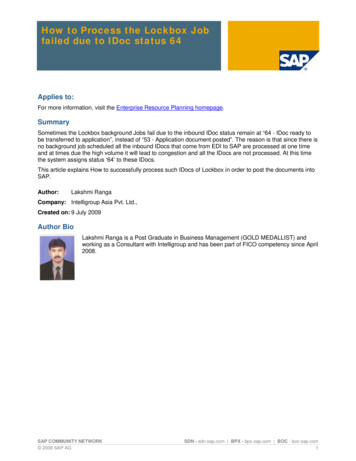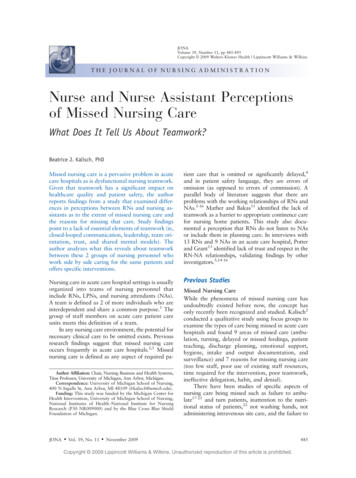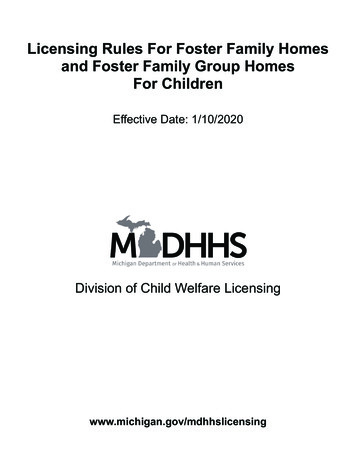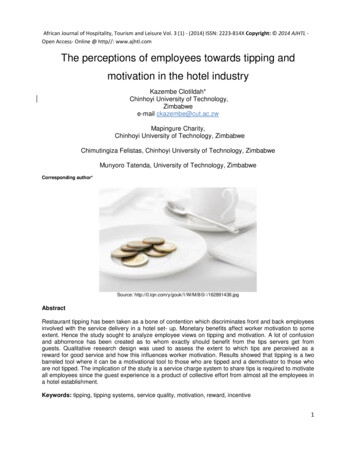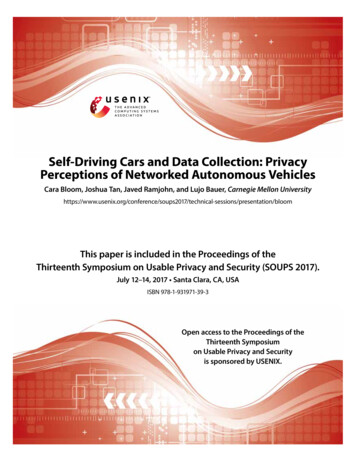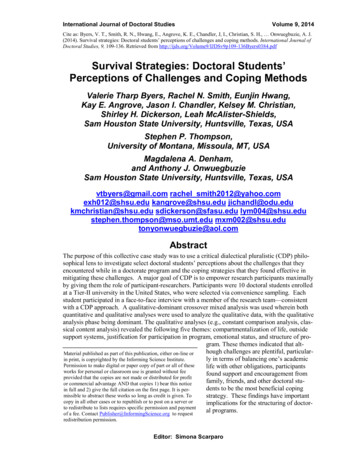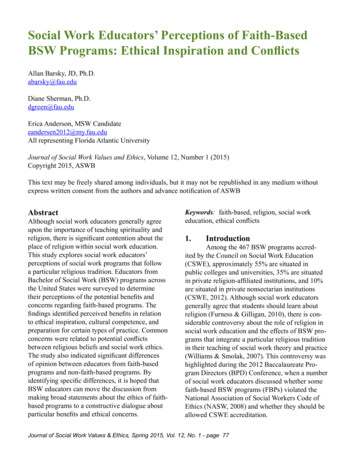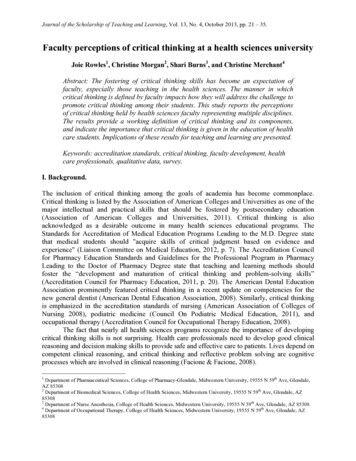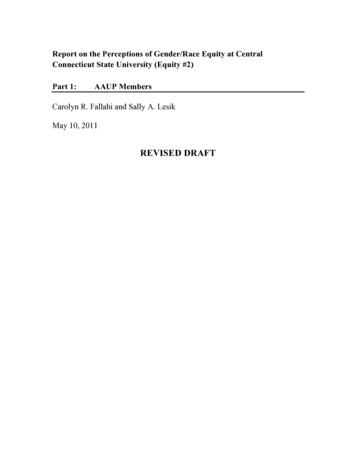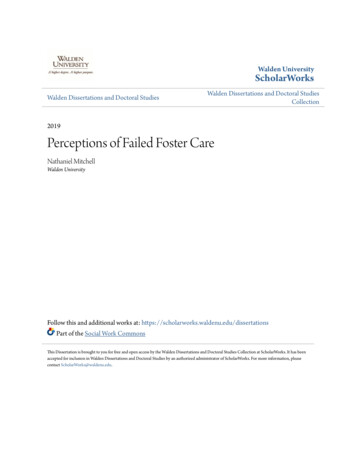
Transcription
Walden UniversityScholarWorksWalden Dissertations and Doctoral StudiesWalden Dissertations and Doctoral StudiesCollection2019Perceptions of Failed Foster CareNathaniel MitchellWalden UniversityFollow this and additional works at: https://scholarworks.waldenu.edu/dissertationsPart of the Social Work CommonsThis Dissertation is brought to you for free and open access by the Walden Dissertations and Doctoral Studies Collection at ScholarWorks. It has beenaccepted for inclusion in Walden Dissertations and Doctoral Studies by an authorized administrator of ScholarWorks. For more information, pleasecontact ScholarWorks@waldenu.edu.
Walden UniversityCollege of Social and Behavioral SciencesThis is to certify that the doctoral study byNathaniel Mitchellhas been found to be complete and satisfactory in all respects,and that any and all revisions required bythe review committee have been made.Review CommitteeDr. Kenneth Larimore, Committee Chairperson, Social Work and Human Service FacilityDr. Kristin Richards, Committee Member, Social Work and Human Services FacultyDr. Nancy Campbell, University Reviewer, Social Work and Human Services FacultyChief Academic OfficerEric Riedel, Ph.D.Walden University2018
AbstractPerceptions of Failed Foster CarebyNathaniel MitchellMSW, Jackson State University, 2003BA, Alcorn State University, 1998Project Submitted in Partial Fulfillmentof the Requirements for the Degree ofDoctor of Social WorkWalden UniversityFebruary 2019
AbstractThe purpose of this action research study was to investigate social workers’ perceptionsof the problems that prevent successful family reunifications after foster care. The studyexplored social workers’ perceptions of barriers that prevent family reunifications incentral Mississippi. Using Bronfenbrenner’s ecological theory as the framework, theresearch question explored the problem from multiple levels of practice including family,individual, institutional, and community. The focus group approach aligned with theproject goal by allowing participants opportunities to share experiences and perspectivesregarding family reunifications. The study used a purposive sample of 10 participantswho were practicing licensed social workers or certified mental health professionals incentral Mississippi. Focus group responses were transcribed and coded by definingcategories, assigning labels, and classifying relevant information using the comparativemethod. The key results of the study included that family reunification was impeded bythe lack of training of child welfare social workers and limited resources to addresspsychosocial issues. The recommendations of the study included improving practice byengaging in mental health screening for foster children and families, promoting currentknowledge and interventions by addressing psychosocial issues, and participating inprogram evaluation by targeting and strengthening policies. The impact of this study forpositive social change includes understanding critical issues of family reunification afterfoster care stemming from lack of resources, unstable placements, and mental healthissues.
Perceptions of Failed Foster CarebyNathaniel MitchellMSW, Jackson State University, 2003BA, Alcorn State University, 1998Project Submitted in Partial Fulfillmentof the Requirements for the Degree ofDoctor of Social WorkWalden UniversityFebruary 2019
DedicationI dedicate this doctoral research to the memory of my deceased mother-in-law,Joyce, for her inspiring vision to pursue higher education for the promotion of morepositive social change. I dedicate this page to my wife, Rashida, for her faith andsacrifice, my daughters, Hope and Makayla, for their understanding and support, and mywife’s aunt, Ola Mae, for her prayers and spiritual guidance. I also dedicate this page tomy mother, Etta, and siblings, John, Brenda, Linda, and Patricia, for arranging familygathering and providing supportive words throughout my studies.
AcknowledgementsI thank God for making it conceivable to accomplish one of the most significanteducational milestone. I acknowledge Walden University for providing exceptionalonline Doctor of Social Work Program that enabled me to have the flexibility to maintainmy career, business, and spend flexible time with my family throughout the academicprocess. I thank the committee Chair Dr. Kenneth Larimore, second committee Dr.Kristin Richards, and the URR, Dr. Nancy Campbell, for their guidance, support, andhelpful contributions throughout the process. I appreciate all professional staff andmentors who taught the required classes and support that helped me to prepare andmanage the rigorous stages of this doctoral study.
Table of ContentsSection 1: Foundation of the Study and Literature Review .1Problem Statement .4Purpose Statement and Research Question .7Research Question .9Definition of Terms.9Significance of the Study .11Theoretical Framework .12Literature Review.15Problems and overview of foster care services .16Fiscal issues: Adoption over reunification. .18Factors affecting reunifications and adoption. .21Micro-Level and Meso-Level Problems to Foster Care Reunifications .21Exosystemic Influences .37Challenging Macro-Systemic Issues .46Summary .48Section 2: Research Design and Data Collection .50Research Design.50Methodology .52i
Participants .53Instrument .55Data Analysis .58Ethical Procedures .60Summary .62Section 3: Presentation of the Findings .63Data Analysis Techniques.63Limitations .66Trustworthiness .66Characteristics of the Participants .68Findings.69Themes .70Summary .73Section 4: Presentation of the Findings .75Application for Professional Ethics in Social Work Practice .76Recommendations for Social Work Practice .78Practice .78Research .78Policy .78ii
Limitations .80Implications for Social Change .81Summary .82References .85Appendix A: Focus Group Protocol .102Appendix B: Confidentiality Agreement .106iii
1Section 1: Foundation of the Study and Literature ReviewPermanency is a crucial outcome for foster care for child welfare services, andeven though the case may remain open for a period of time, family reunification is thepreferred permanency goal. Unfortunately, this desired result is not always possible. Iinvestigated failed family reunifications at the family, individual, community, andinstitutional levels from practitioners’ points of view. The social welfare dilemmaassociated with the family reunifications process is affected by many factors: (a) poverty,(b) social, political, and cultural environment; age of the child, (c) implausibility due toparental imprisonment, (d) drift patterns, (e) neglect due to addiction or drug dependencein parents, (f) availability of therapeutic foster care, or (g) unlicensed and untrained fosterparents (Dettlaf, Graham, Holzman, Baumann, & Fluke, 2015; Koh, Rolock, Cross, &Eblen-Manning, 2014; Lopez, del Valle, Montserrat, & Bravo, 2013).Using a phenomenological methodology, I interviewed 10 agency social workpractitioners from two organizations in central Mississippi who specialize in foster care.The members participated in focus groups to promote opportunities to share professionalexperiences and perspectives. The significance of the study was that I examined thepotential contributions of the project to the field of social work. This section includesinformation regarding the nature of the study, theoretical /conceptual framework, valuesand ethics, and review of the professional and academic literature.The implications for positive social change of this study are to provide knowledgeof failed family reunifications for training and improve practical approaches that will help
2shape more successful family reunifications. The study will help foster care agenciesidentify conditions that contribute to failed family reunifications for more successfultreatment planning. The results will help social organizations understand the complexitiesof family reunifications.I will present this study in four sections. Section 1 is the introductory section. Thissection consists of the introduction, statement of the problem, the purpose of the study,and the research questions. In this action research project, I highlight the gap in theliterature that informs local and national social practice issues: failed reunifications offamilies.The theoretical framework—Bronfenbrenner’s ecological framework—iscarefully considered to support the research (Bronfenbrenner, 1981). The benefits of theecological framework are aligned with the research questions at all levels of practice:individual, family, institutional, community. Micro-level social work is a term used torefer to the practice of working directly with an individual or family. Macro-level socialwork practices are large-scale interventions that have significant impacts on thehealthcare systems as well as the communities affected by the care systems. Meso-levelpractices, which deal with smaller units, institutions, or groups, fall in between the microand macro-levels. The purpose of the research was to facilitate discussion of foster carereunifications with the goal of investigating the problems with successful familyreunifications after foster care. Family reunification occurs when children are
3successfully returned to their biological families. This placement is the best solution forthe children and families when conditions allow (Gilligan, 1997; Ryan et al., 2016;Whittaker & Maluccio, 2002).I will use the values and principles cited in part 5.02 (Evaluation and Research) ofthe NASW Code of Ethics (2017) to support the values and principles of this research. Imaintained positive regard for the members’ privacy, dignity, and well-being. Beforeevaluation or research, I included written and voluntary informed consent from theparticipants, as appropriate, without actual or implied sanction for refusal to participate.Section 1 includes a review of literature exploring the deterrents and determinantsto successful reunifications of families after foster care. The review begins with the childand family factors and expands from neighborhoods, schools, and social elements tosocietal and governmental influences on family reunifications. The literature review wasnot limited to the micro- and meso-systems, but the emphasis was placed on situationsthat affect the perceptions of child welfare workers.I addressed sources of the data and summary of the methodology used to organizeand analyze the findings including the design of the study, methods, and procedures inSection 2. The findings of the study were presented in Section 3. Section 4 included thesummary, the implications of the study, and recommendations for further study.Appendices follow Section 4.
4Problem StatementThe complex psychosocial issues that have complicated social workers’ strategiesto successfully reunify families are of concern to social work practitioners (Collins, Paris,& Ward, 2008; Crandall, 2013; Geomans, Van Gell, Van Beem, & Vedder, 2016).According to Ryan, Victor, Moore, Mowbray, and Perron (2016), the major purpose ofthe foster care systems is reunification, which often informs the development of policyframeworks or decision-making processes. However, even considering the importance ofthis area to healthcare delivery, few studies have been conducted to investigate thesignificance to families of reunification as well as the reintegration of children into theirbirth families. Worker views and characteristics, as well as the perspectives ofcaregivers, birth parents and especially fathers, and children have tended to be neglected(Fernandez, 2013). I designed this action research study to investigate social workers’perceptions of the problems that prevent successful family reunifications after foster care.In 2015, more than 400,000 children were placed in foster care systemsthroughout the United States (Holt & Kelly, 2015). More than half remained in fostercare longer than anticipated due to failed service agreements between the parents and theDepartment of Human Services (Holt & Kelly, 2015). The social work practitionersexperienced adverse outcomes with foster care reunifications as parents face complicatedissues with limited social support and resources (Brisobois & Marsack, 2015). InMississippi, thirty-eight percent of 2,340 failed reunifications were due to lack oftraining, inadequate caseload management, and system turnover (CWLA, 2016).
5The failure of family reunifications has led to the termination of parental rights,multiple placements, and families separated from biological siblings and other members.The elements of separation may involve children placed at separate locations, whichimpedes regular contact needed for more successful reunifications. For example, Fraidin(2012b) noted that children might be removed from their family of origin by wellmeaning social workers and courts when other more beneficial solutions were available.Florida is a perfect example of a state that has decided to invest more on familypreservation as opposed to care given after the family has broken. Consequently,Florida’s state foster care system has yielded significant results evidenced by thereduction of children (around 7000) who have been separated from their families. In the 2years that the foster care system has been implemented, the reunification has improveddramatically, in both expediency and scale (Fraidin, 2012).The social welfare dilemma associated with the family reunification process isaffected by several factors: (a) age of the child, (b) implausibility due to parentalimprisonment, (c) drift patterns, (d) neglect due to addiction or drug dependence inparents, (e) short-term or long-term fostering, (f) poverty, (g) access to mental healthcounselling; and (h) social, political, and cultural environment (Dettlaf et. al., 2015; Kohet al., 2014; Lopez et. al., 2013). Deprivation and poverty cause children to be repeatedlyplaced in foster care and cause failed reunifications efforts (Fraidin, 2012b). Social andeconomic status of biological families often predicts how child welfare placements aremade (Fraidin, 2012b). Family mental health concerns also affect decisions involvingchildren in the foster care system (Barth, Wildfire, & Green, 2006). The key criterion for
6admission into the Child Welfare Services (CWS) is child maltreatment. McLeod andShanahan (1996) found factors like poverty are responsible for the mental healthproblems that affect these children. The tough economic conditions that the parents havebeen subjected to can make parents more aggressive and punitive toward their children aswell as less concerned about their children’s needs (Barth & Blythe, 1983; Fraidin,2012b). Consequently, these environments give children mental health problems, whichhave been cited as the most significant contributor to the placement of children in out-ofhome care.The CWS currently receives a number of children afflicted with mental healthissues engendered by diverse reasons that are not always directly linked to parentalmaltreatment (United States Government Accounting Office [U.S. GAO], 2003).According to Giliberti and Schilzinger (2000), the most significant risk to the safety ofchildren has been associated with parenting as well as environmental and situationalfactors such as homelessness and poverty, there are other factors that significantly poserisks to the safety of children such as parental health problems, domestic violence,children’s disabilities or special needs, social isolation, and parental substance abuse(Pecora, Whittaker, Maluccio, & Barth, 2012). Active domestic violence, substanceabuse, and parental mental illness are the most prevalent risk factors (Barth et al., 2006).Reunifications as a permanency plan in the best interests of the child require activeparticipation and contributions from all levels of the ecological system–the court,government agencies, and the family–for successful outcomes (Lercara, 2016).
7Lercara (2016) described how states demonstrate the lack of uniform interest forthe children and families and reasonable efforts to reunify them. The author suggestedthat the Adoption and Safe Families Act of 1997 (ASFA) has failed to define reasonableefforts and failed to establish clarity and consistency for successful reunifications. Fraidin(2012b) noted that in sixty percent of cases studied at the University of the District ofColumbia in Washington D.C., a safe return of a child to his or her birth parents waspossible. For example, in one case a fami
MSW, Jackson State University, 2003 BA, Alcorn State University, 1998 Project Submitted in Partial Fulfillment of the Requirements for the Degree of D
